Green Building Design & Sustainability
VerifiedAdded on 2020/03/04
|13
|3319
|41
AI Summary
This assignment delves into the principles of green building design and its integration across various project phases. It examines the crucial role of early stage decisions in achieving sustainable construction practices while minimizing costs. The document emphasizes the importance of BIM (Building Information Modeling) for conceptual design analysis and sustainability assessment. It also explores constraints commonly encountered in construction projects, highlighting their influence on green building implementation. Further, the assignment discusses the impact of green buildings on employee health and productivity, showcasing the broader benefits of sustainable design.
Contribute Materials
Your contribution can guide someone’s learning journey. Share your
documents today.
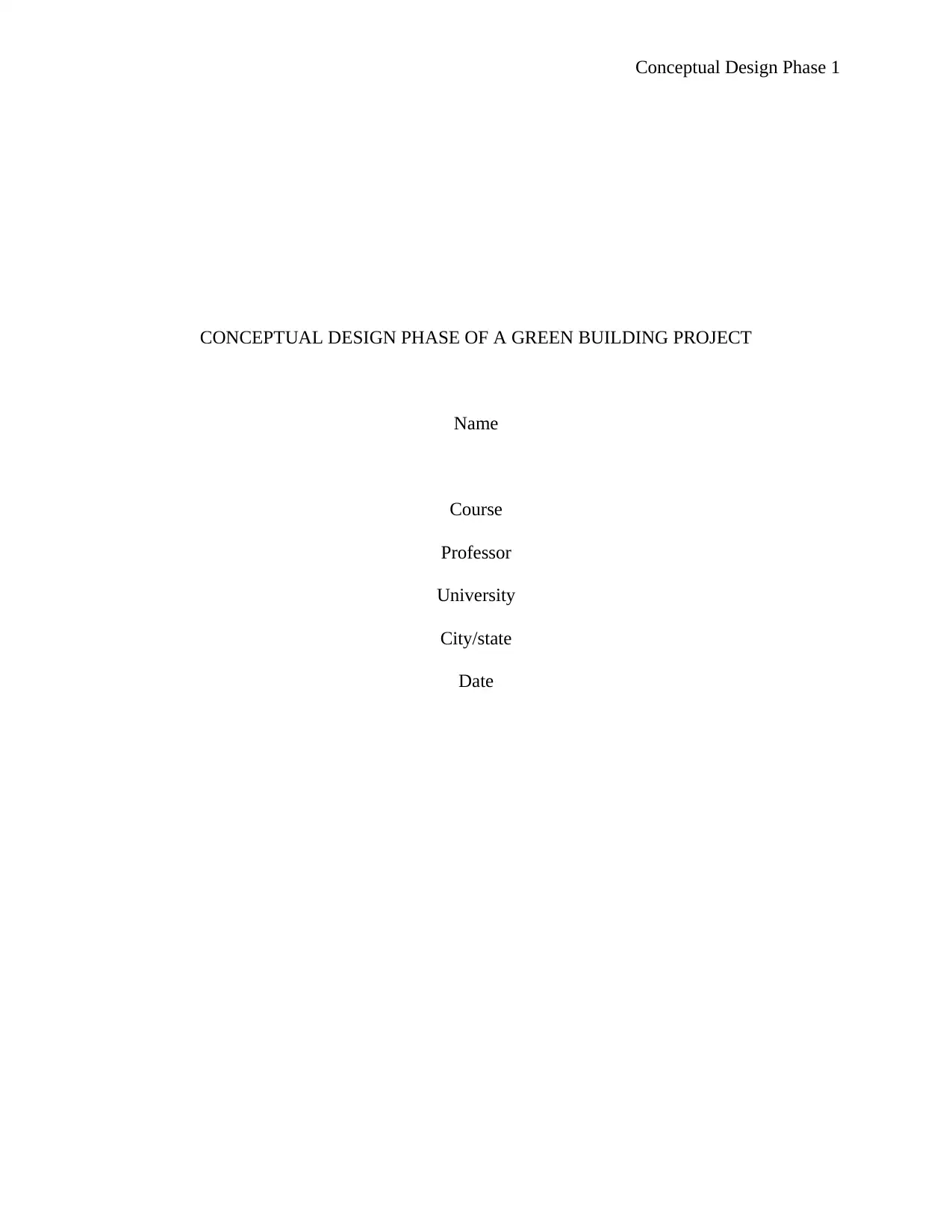
Conceptual Design Phase 1
CONCEPTUAL DESIGN PHASE OF A GREEN BUILDING PROJECT
Name
Course
Professor
University
City/state
Date
CONCEPTUAL DESIGN PHASE OF A GREEN BUILDING PROJECT
Name
Course
Professor
University
City/state
Date
Secure Best Marks with AI Grader
Need help grading? Try our AI Grader for instant feedback on your assignments.
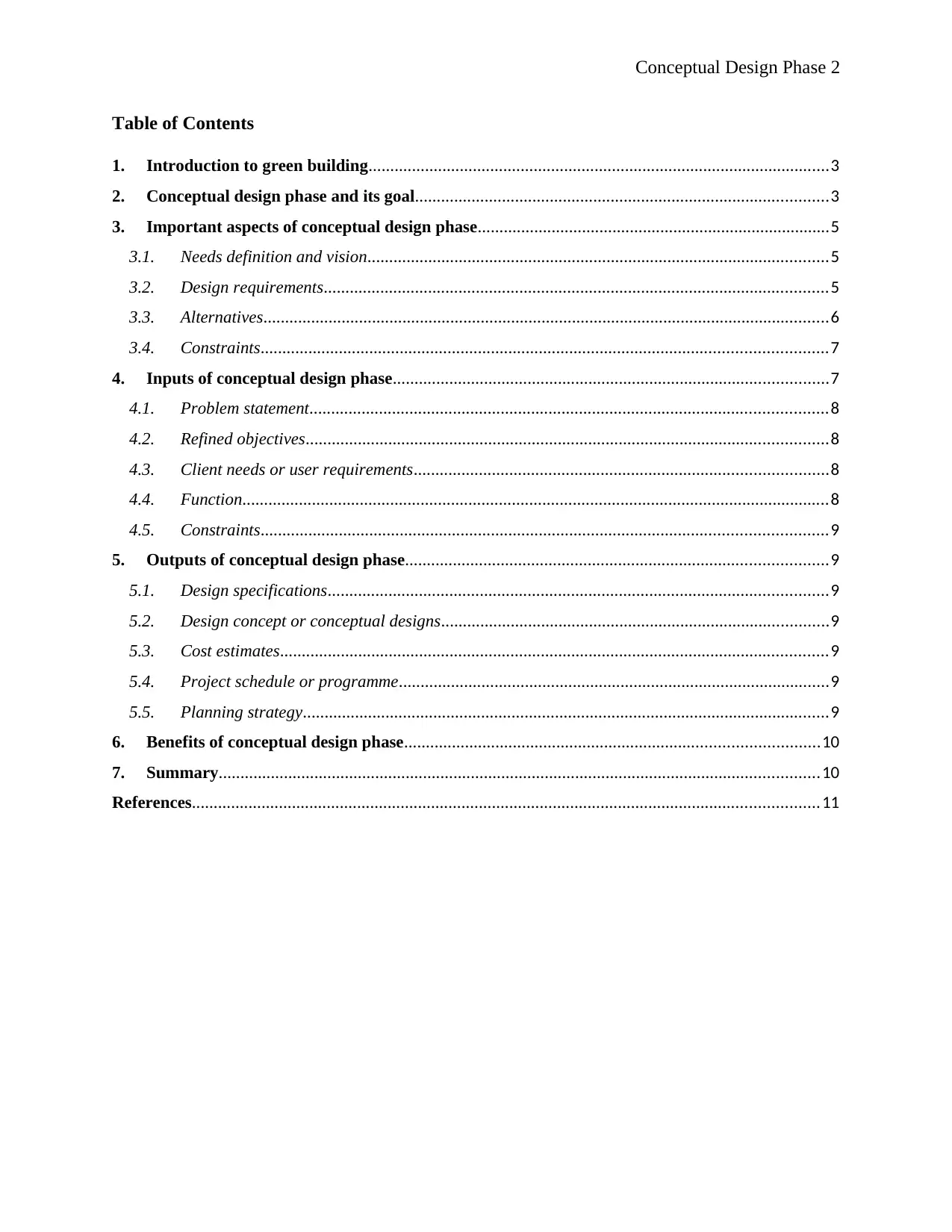
Conceptual Design Phase 2
Table of Contents
1. Introduction to green building..........................................................................................................3
2. Conceptual design phase and its goal...............................................................................................3
3. Important aspects of conceptual design phase.................................................................................5
3.1. Needs definition and vision..........................................................................................................5
3.2. Design requirements....................................................................................................................5
3.3. Alternatives..................................................................................................................................6
3.4. Constraints..................................................................................................................................7
4. Inputs of conceptual design phase....................................................................................................7
4.1. Problem statement.......................................................................................................................8
4.2. Refined objectives........................................................................................................................8
4.3. Client needs or user requirements...............................................................................................8
4.4. Function.......................................................................................................................................8
4.5. Constraints..................................................................................................................................9
5. Outputs of conceptual design phase.................................................................................................9
5.1. Design specifications...................................................................................................................9
5.2. Design concept or conceptual designs.........................................................................................9
5.3. Cost estimates..............................................................................................................................9
5.4. Project schedule or programme...................................................................................................9
5.5. Planning strategy.........................................................................................................................9
6. Benefits of conceptual design phase...............................................................................................10
7. Summary..........................................................................................................................................10
References................................................................................................................................................11
Table of Contents
1. Introduction to green building..........................................................................................................3
2. Conceptual design phase and its goal...............................................................................................3
3. Important aspects of conceptual design phase.................................................................................5
3.1. Needs definition and vision..........................................................................................................5
3.2. Design requirements....................................................................................................................5
3.3. Alternatives..................................................................................................................................6
3.4. Constraints..................................................................................................................................7
4. Inputs of conceptual design phase....................................................................................................7
4.1. Problem statement.......................................................................................................................8
4.2. Refined objectives........................................................................................................................8
4.3. Client needs or user requirements...............................................................................................8
4.4. Function.......................................................................................................................................8
4.5. Constraints..................................................................................................................................9
5. Outputs of conceptual design phase.................................................................................................9
5.1. Design specifications...................................................................................................................9
5.2. Design concept or conceptual designs.........................................................................................9
5.3. Cost estimates..............................................................................................................................9
5.4. Project schedule or programme...................................................................................................9
5.5. Planning strategy.........................................................................................................................9
6. Benefits of conceptual design phase...............................................................................................10
7. Summary..........................................................................................................................................10
References................................................................................................................................................11
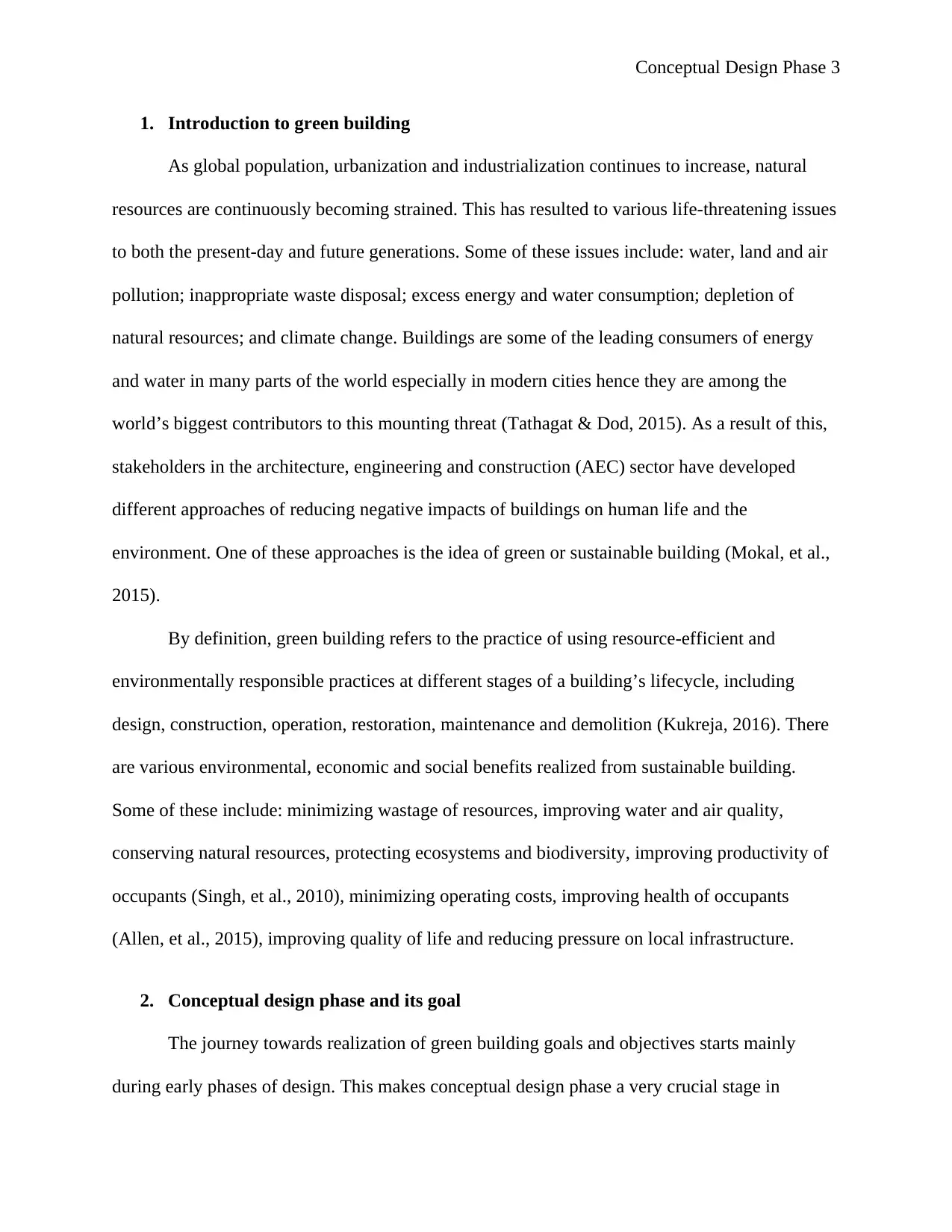
Conceptual Design Phase 3
1. Introduction to green building
As global population, urbanization and industrialization continues to increase, natural
resources are continuously becoming strained. This has resulted to various life-threatening issues
to both the present-day and future generations. Some of these issues include: water, land and air
pollution; inappropriate waste disposal; excess energy and water consumption; depletion of
natural resources; and climate change. Buildings are some of the leading consumers of energy
and water in many parts of the world especially in modern cities hence they are among the
world’s biggest contributors to this mounting threat (Tathagat & Dod, 2015). As a result of this,
stakeholders in the architecture, engineering and construction (AEC) sector have developed
different approaches of reducing negative impacts of buildings on human life and the
environment. One of these approaches is the idea of green or sustainable building (Mokal, et al.,
2015).
By definition, green building refers to the practice of using resource-efficient and
environmentally responsible practices at different stages of a building’s lifecycle, including
design, construction, operation, restoration, maintenance and demolition (Kukreja, 2016). There
are various environmental, economic and social benefits realized from sustainable building.
Some of these include: minimizing wastage of resources, improving water and air quality,
conserving natural resources, protecting ecosystems and biodiversity, improving productivity of
occupants (Singh, et al., 2010), minimizing operating costs, improving health of occupants
(Allen, et al., 2015), improving quality of life and reducing pressure on local infrastructure.
2. Conceptual design phase and its goal
The journey towards realization of green building goals and objectives starts mainly
during early phases of design. This makes conceptual design phase a very crucial stage in
1. Introduction to green building
As global population, urbanization and industrialization continues to increase, natural
resources are continuously becoming strained. This has resulted to various life-threatening issues
to both the present-day and future generations. Some of these issues include: water, land and air
pollution; inappropriate waste disposal; excess energy and water consumption; depletion of
natural resources; and climate change. Buildings are some of the leading consumers of energy
and water in many parts of the world especially in modern cities hence they are among the
world’s biggest contributors to this mounting threat (Tathagat & Dod, 2015). As a result of this,
stakeholders in the architecture, engineering and construction (AEC) sector have developed
different approaches of reducing negative impacts of buildings on human life and the
environment. One of these approaches is the idea of green or sustainable building (Mokal, et al.,
2015).
By definition, green building refers to the practice of using resource-efficient and
environmentally responsible practices at different stages of a building’s lifecycle, including
design, construction, operation, restoration, maintenance and demolition (Kukreja, 2016). There
are various environmental, economic and social benefits realized from sustainable building.
Some of these include: minimizing wastage of resources, improving water and air quality,
conserving natural resources, protecting ecosystems and biodiversity, improving productivity of
occupants (Singh, et al., 2010), minimizing operating costs, improving health of occupants
(Allen, et al., 2015), improving quality of life and reducing pressure on local infrastructure.
2. Conceptual design phase and its goal
The journey towards realization of green building goals and objectives starts mainly
during early phases of design. This makes conceptual design phase a very crucial stage in
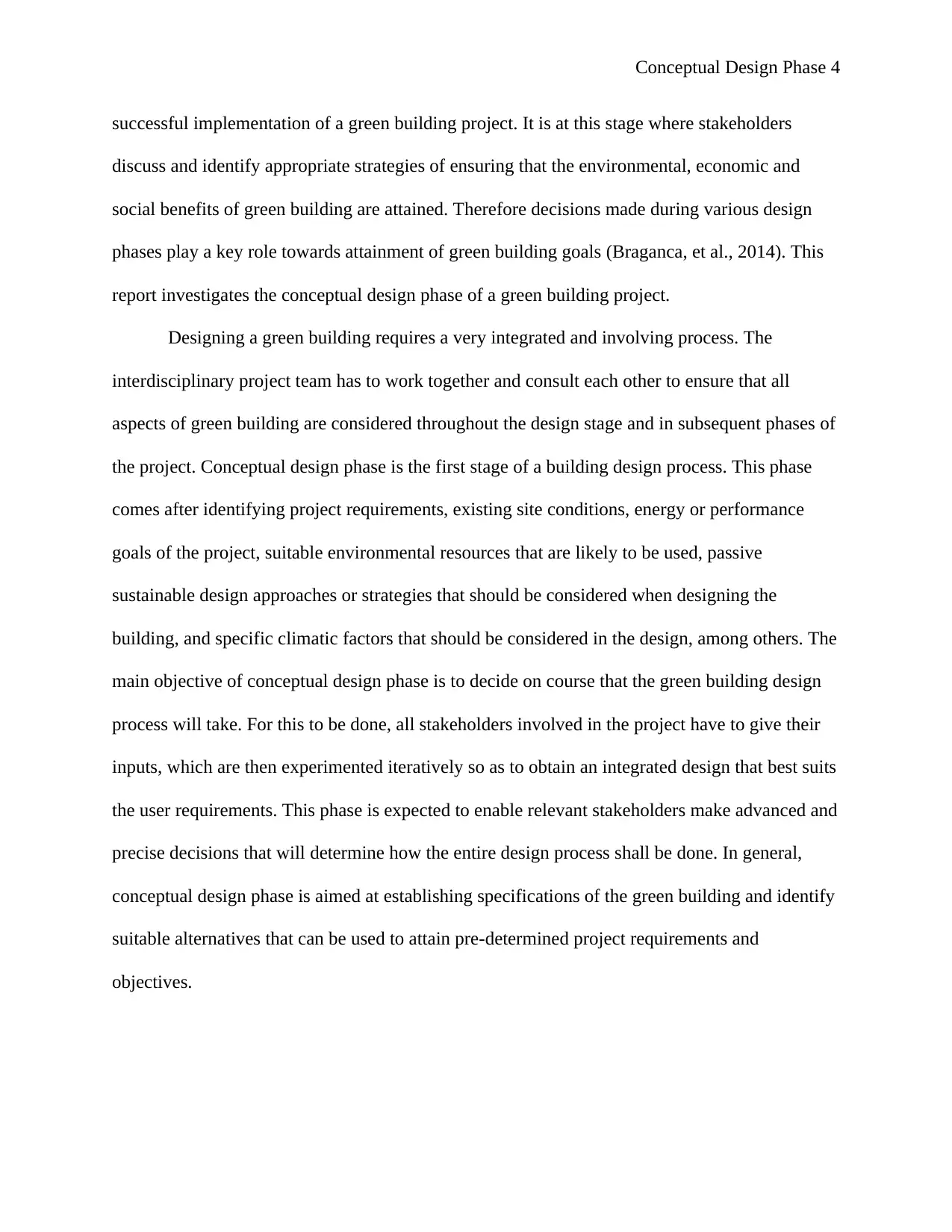
Conceptual Design Phase 4
successful implementation of a green building project. It is at this stage where stakeholders
discuss and identify appropriate strategies of ensuring that the environmental, economic and
social benefits of green building are attained. Therefore decisions made during various design
phases play a key role towards attainment of green building goals (Braganca, et al., 2014). This
report investigates the conceptual design phase of a green building project.
Designing a green building requires a very integrated and involving process. The
interdisciplinary project team has to work together and consult each other to ensure that all
aspects of green building are considered throughout the design stage and in subsequent phases of
the project. Conceptual design phase is the first stage of a building design process. This phase
comes after identifying project requirements, existing site conditions, energy or performance
goals of the project, suitable environmental resources that are likely to be used, passive
sustainable design approaches or strategies that should be considered when designing the
building, and specific climatic factors that should be considered in the design, among others. The
main objective of conceptual design phase is to decide on course that the green building design
process will take. For this to be done, all stakeholders involved in the project have to give their
inputs, which are then experimented iteratively so as to obtain an integrated design that best suits
the user requirements. This phase is expected to enable relevant stakeholders make advanced and
precise decisions that will determine how the entire design process shall be done. In general,
conceptual design phase is aimed at establishing specifications of the green building and identify
suitable alternatives that can be used to attain pre-determined project requirements and
objectives.
successful implementation of a green building project. It is at this stage where stakeholders
discuss and identify appropriate strategies of ensuring that the environmental, economic and
social benefits of green building are attained. Therefore decisions made during various design
phases play a key role towards attainment of green building goals (Braganca, et al., 2014). This
report investigates the conceptual design phase of a green building project.
Designing a green building requires a very integrated and involving process. The
interdisciplinary project team has to work together and consult each other to ensure that all
aspects of green building are considered throughout the design stage and in subsequent phases of
the project. Conceptual design phase is the first stage of a building design process. This phase
comes after identifying project requirements, existing site conditions, energy or performance
goals of the project, suitable environmental resources that are likely to be used, passive
sustainable design approaches or strategies that should be considered when designing the
building, and specific climatic factors that should be considered in the design, among others. The
main objective of conceptual design phase is to decide on course that the green building design
process will take. For this to be done, all stakeholders involved in the project have to give their
inputs, which are then experimented iteratively so as to obtain an integrated design that best suits
the user requirements. This phase is expected to enable relevant stakeholders make advanced and
precise decisions that will determine how the entire design process shall be done. In general,
conceptual design phase is aimed at establishing specifications of the green building and identify
suitable alternatives that can be used to attain pre-determined project requirements and
objectives.
Secure Best Marks with AI Grader
Need help grading? Try our AI Grader for instant feedback on your assignments.
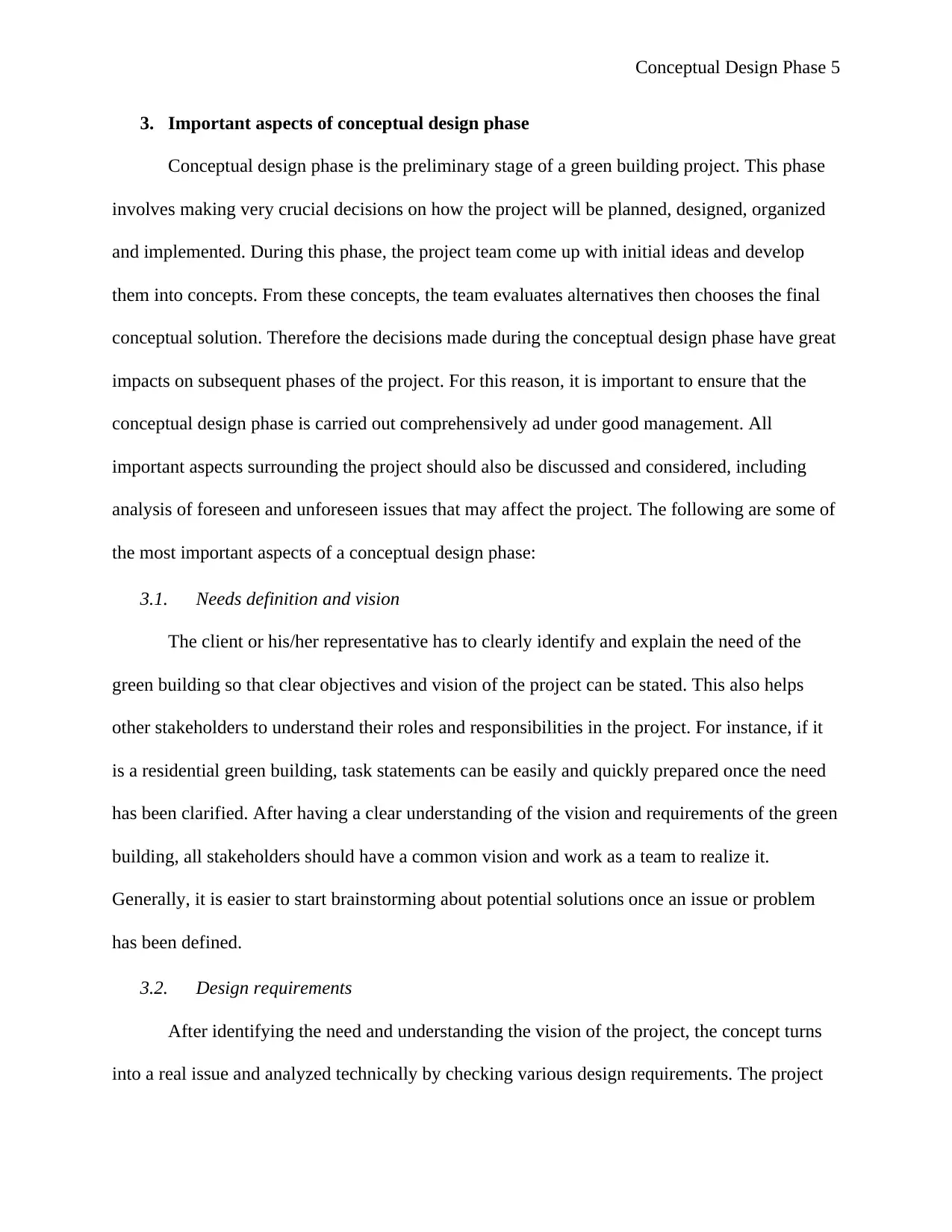
Conceptual Design Phase 5
3. Important aspects of conceptual design phase
Conceptual design phase is the preliminary stage of a green building project. This phase
involves making very crucial decisions on how the project will be planned, designed, organized
and implemented. During this phase, the project team come up with initial ideas and develop
them into concepts. From these concepts, the team evaluates alternatives then chooses the final
conceptual solution. Therefore the decisions made during the conceptual design phase have great
impacts on subsequent phases of the project. For this reason, it is important to ensure that the
conceptual design phase is carried out comprehensively ad under good management. All
important aspects surrounding the project should also be discussed and considered, including
analysis of foreseen and unforeseen issues that may affect the project. The following are some of
the most important aspects of a conceptual design phase:
3.1. Needs definition and vision
The client or his/her representative has to clearly identify and explain the need of the
green building so that clear objectives and vision of the project can be stated. This also helps
other stakeholders to understand their roles and responsibilities in the project. For instance, if it
is a residential green building, task statements can be easily and quickly prepared once the need
has been clarified. After having a clear understanding of the vision and requirements of the green
building, all stakeholders should have a common vision and work as a team to realize it.
Generally, it is easier to start brainstorming about potential solutions once an issue or problem
has been defined.
3.2. Design requirements
After identifying the need and understanding the vision of the project, the concept turns
into a real issue and analyzed technically by checking various design requirements. The project
3. Important aspects of conceptual design phase
Conceptual design phase is the preliminary stage of a green building project. This phase
involves making very crucial decisions on how the project will be planned, designed, organized
and implemented. During this phase, the project team come up with initial ideas and develop
them into concepts. From these concepts, the team evaluates alternatives then chooses the final
conceptual solution. Therefore the decisions made during the conceptual design phase have great
impacts on subsequent phases of the project. For this reason, it is important to ensure that the
conceptual design phase is carried out comprehensively ad under good management. All
important aspects surrounding the project should also be discussed and considered, including
analysis of foreseen and unforeseen issues that may affect the project. The following are some of
the most important aspects of a conceptual design phase:
3.1. Needs definition and vision
The client or his/her representative has to clearly identify and explain the need of the
green building so that clear objectives and vision of the project can be stated. This also helps
other stakeholders to understand their roles and responsibilities in the project. For instance, if it
is a residential green building, task statements can be easily and quickly prepared once the need
has been clarified. After having a clear understanding of the vision and requirements of the green
building, all stakeholders should have a common vision and work as a team to realize it.
Generally, it is easier to start brainstorming about potential solutions once an issue or problem
has been defined.
3.2. Design requirements
After identifying the need and understanding the vision of the project, the concept turns
into a real issue and analyzed technically by checking various design requirements. The project
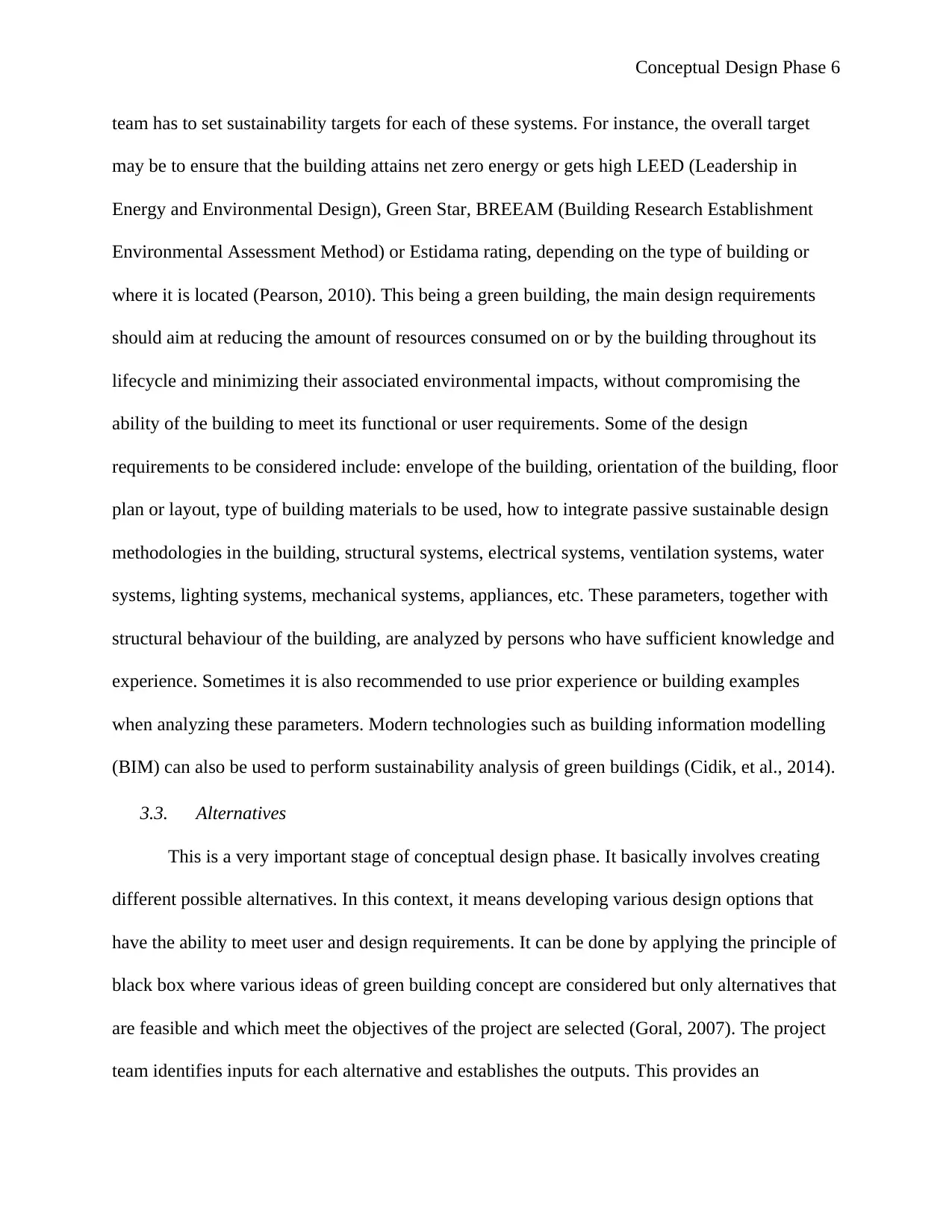
Conceptual Design Phase 6
team has to set sustainability targets for each of these systems. For instance, the overall target
may be to ensure that the building attains net zero energy or gets high LEED (Leadership in
Energy and Environmental Design), Green Star, BREEAM (Building Research Establishment
Environmental Assessment Method) or Estidama rating, depending on the type of building or
where it is located (Pearson, 2010). This being a green building, the main design requirements
should aim at reducing the amount of resources consumed on or by the building throughout its
lifecycle and minimizing their associated environmental impacts, without compromising the
ability of the building to meet its functional or user requirements. Some of the design
requirements to be considered include: envelope of the building, orientation of the building, floor
plan or layout, type of building materials to be used, how to integrate passive sustainable design
methodologies in the building, structural systems, electrical systems, ventilation systems, water
systems, lighting systems, mechanical systems, appliances, etc. These parameters, together with
structural behaviour of the building, are analyzed by persons who have sufficient knowledge and
experience. Sometimes it is also recommended to use prior experience or building examples
when analyzing these parameters. Modern technologies such as building information modelling
(BIM) can also be used to perform sustainability analysis of green buildings (Cidik, et al., 2014).
3.3. Alternatives
This is a very important stage of conceptual design phase. It basically involves creating
different possible alternatives. In this context, it means developing various design options that
have the ability to meet user and design requirements. It can be done by applying the principle of
black box where various ideas of green building concept are considered but only alternatives that
are feasible and which meet the objectives of the project are selected (Goral, 2007). The project
team identifies inputs for each alternative and establishes the outputs. This provides an
team has to set sustainability targets for each of these systems. For instance, the overall target
may be to ensure that the building attains net zero energy or gets high LEED (Leadership in
Energy and Environmental Design), Green Star, BREEAM (Building Research Establishment
Environmental Assessment Method) or Estidama rating, depending on the type of building or
where it is located (Pearson, 2010). This being a green building, the main design requirements
should aim at reducing the amount of resources consumed on or by the building throughout its
lifecycle and minimizing their associated environmental impacts, without compromising the
ability of the building to meet its functional or user requirements. Some of the design
requirements to be considered include: envelope of the building, orientation of the building, floor
plan or layout, type of building materials to be used, how to integrate passive sustainable design
methodologies in the building, structural systems, electrical systems, ventilation systems, water
systems, lighting systems, mechanical systems, appliances, etc. These parameters, together with
structural behaviour of the building, are analyzed by persons who have sufficient knowledge and
experience. Sometimes it is also recommended to use prior experience or building examples
when analyzing these parameters. Modern technologies such as building information modelling
(BIM) can also be used to perform sustainability analysis of green buildings (Cidik, et al., 2014).
3.3. Alternatives
This is a very important stage of conceptual design phase. It basically involves creating
different possible alternatives. In this context, it means developing various design options that
have the ability to meet user and design requirements. It can be done by applying the principle of
black box where various ideas of green building concept are considered but only alternatives that
are feasible and which meet the objectives of the project are selected (Goral, 2007). The project
team identifies inputs for each alternative and establishes the outputs. This provides an
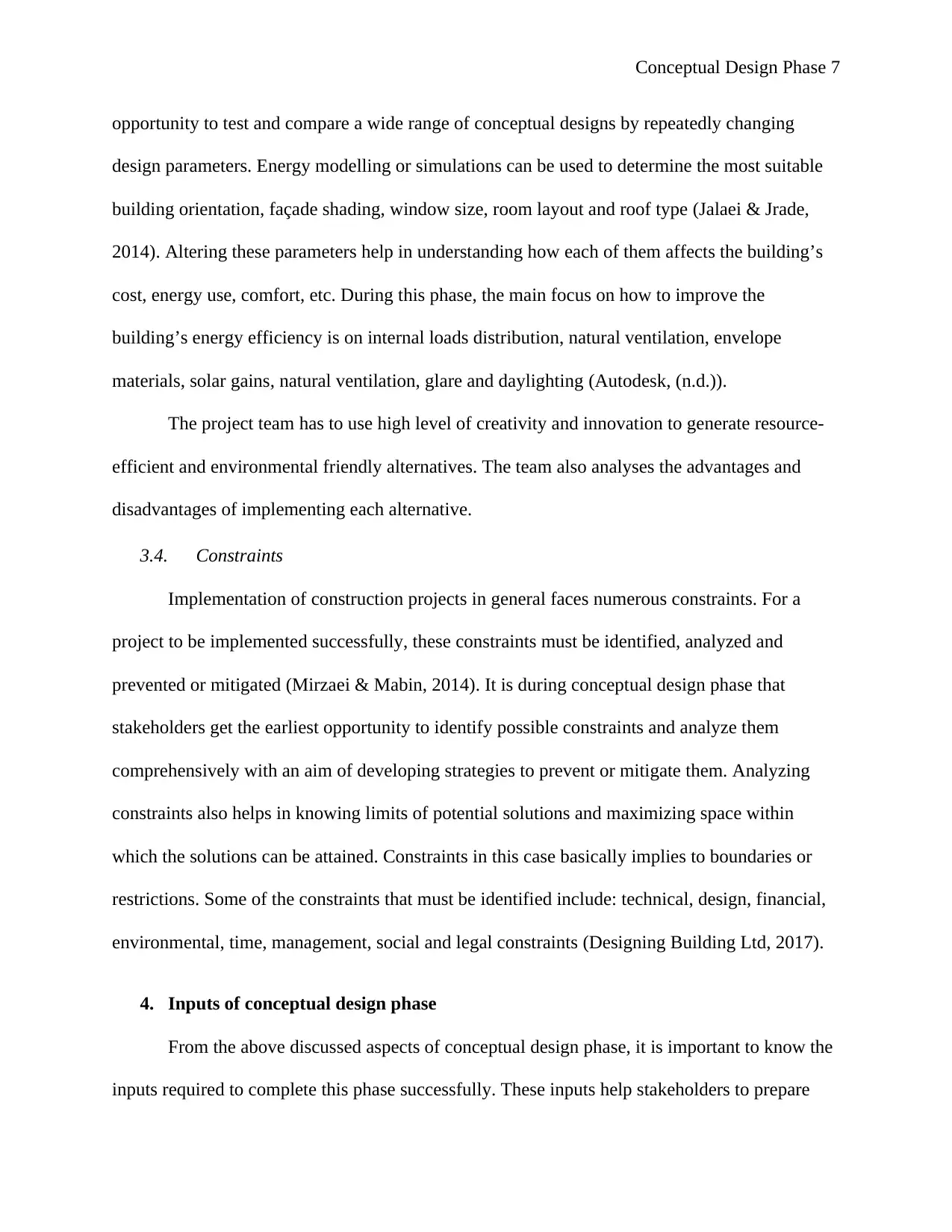
Conceptual Design Phase 7
opportunity to test and compare a wide range of conceptual designs by repeatedly changing
design parameters. Energy modelling or simulations can be used to determine the most suitable
building orientation, façade shading, window size, room layout and roof type (Jalaei & Jrade,
2014). Altering these parameters help in understanding how each of them affects the building’s
cost, energy use, comfort, etc. During this phase, the main focus on how to improve the
building’s energy efficiency is on internal loads distribution, natural ventilation, envelope
materials, solar gains, natural ventilation, glare and daylighting (Autodesk, (n.d.)).
The project team has to use high level of creativity and innovation to generate resource-
efficient and environmental friendly alternatives. The team also analyses the advantages and
disadvantages of implementing each alternative.
3.4. Constraints
Implementation of construction projects in general faces numerous constraints. For a
project to be implemented successfully, these constraints must be identified, analyzed and
prevented or mitigated (Mirzaei & Mabin, 2014). It is during conceptual design phase that
stakeholders get the earliest opportunity to identify possible constraints and analyze them
comprehensively with an aim of developing strategies to prevent or mitigate them. Analyzing
constraints also helps in knowing limits of potential solutions and maximizing space within
which the solutions can be attained. Constraints in this case basically implies to boundaries or
restrictions. Some of the constraints that must be identified include: technical, design, financial,
environmental, time, management, social and legal constraints (Designing Building Ltd, 2017).
4. Inputs of conceptual design phase
From the above discussed aspects of conceptual design phase, it is important to know the
inputs required to complete this phase successfully. These inputs help stakeholders to prepare
opportunity to test and compare a wide range of conceptual designs by repeatedly changing
design parameters. Energy modelling or simulations can be used to determine the most suitable
building orientation, façade shading, window size, room layout and roof type (Jalaei & Jrade,
2014). Altering these parameters help in understanding how each of them affects the building’s
cost, energy use, comfort, etc. During this phase, the main focus on how to improve the
building’s energy efficiency is on internal loads distribution, natural ventilation, envelope
materials, solar gains, natural ventilation, glare and daylighting (Autodesk, (n.d.)).
The project team has to use high level of creativity and innovation to generate resource-
efficient and environmental friendly alternatives. The team also analyses the advantages and
disadvantages of implementing each alternative.
3.4. Constraints
Implementation of construction projects in general faces numerous constraints. For a
project to be implemented successfully, these constraints must be identified, analyzed and
prevented or mitigated (Mirzaei & Mabin, 2014). It is during conceptual design phase that
stakeholders get the earliest opportunity to identify possible constraints and analyze them
comprehensively with an aim of developing strategies to prevent or mitigate them. Analyzing
constraints also helps in knowing limits of potential solutions and maximizing space within
which the solutions can be attained. Constraints in this case basically implies to boundaries or
restrictions. Some of the constraints that must be identified include: technical, design, financial,
environmental, time, management, social and legal constraints (Designing Building Ltd, 2017).
4. Inputs of conceptual design phase
From the above discussed aspects of conceptual design phase, it is important to know the
inputs required to complete this phase successfully. These inputs help stakeholders to prepare
Paraphrase This Document
Need a fresh take? Get an instant paraphrase of this document with our AI Paraphraser
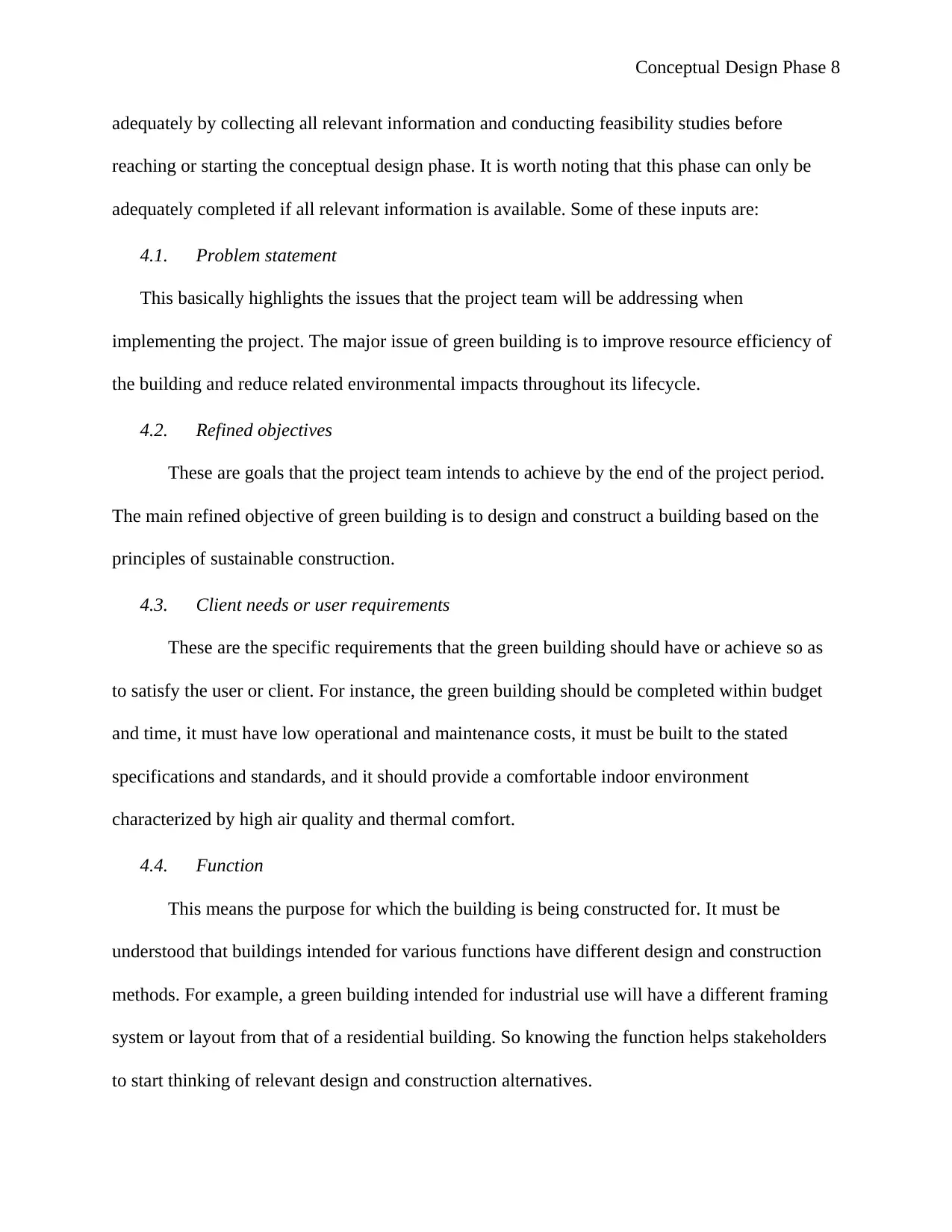
Conceptual Design Phase 8
adequately by collecting all relevant information and conducting feasibility studies before
reaching or starting the conceptual design phase. It is worth noting that this phase can only be
adequately completed if all relevant information is available. Some of these inputs are:
4.1. Problem statement
This basically highlights the issues that the project team will be addressing when
implementing the project. The major issue of green building is to improve resource efficiency of
the building and reduce related environmental impacts throughout its lifecycle.
4.2. Refined objectives
These are goals that the project team intends to achieve by the end of the project period.
The main refined objective of green building is to design and construct a building based on the
principles of sustainable construction.
4.3. Client needs or user requirements
These are the specific requirements that the green building should have or achieve so as
to satisfy the user or client. For instance, the green building should be completed within budget
and time, it must have low operational and maintenance costs, it must be built to the stated
specifications and standards, and it should provide a comfortable indoor environment
characterized by high air quality and thermal comfort.
4.4. Function
This means the purpose for which the building is being constructed for. It must be
understood that buildings intended for various functions have different design and construction
methods. For example, a green building intended for industrial use will have a different framing
system or layout from that of a residential building. So knowing the function helps stakeholders
to start thinking of relevant design and construction alternatives.
adequately by collecting all relevant information and conducting feasibility studies before
reaching or starting the conceptual design phase. It is worth noting that this phase can only be
adequately completed if all relevant information is available. Some of these inputs are:
4.1. Problem statement
This basically highlights the issues that the project team will be addressing when
implementing the project. The major issue of green building is to improve resource efficiency of
the building and reduce related environmental impacts throughout its lifecycle.
4.2. Refined objectives
These are goals that the project team intends to achieve by the end of the project period.
The main refined objective of green building is to design and construct a building based on the
principles of sustainable construction.
4.3. Client needs or user requirements
These are the specific requirements that the green building should have or achieve so as
to satisfy the user or client. For instance, the green building should be completed within budget
and time, it must have low operational and maintenance costs, it must be built to the stated
specifications and standards, and it should provide a comfortable indoor environment
characterized by high air quality and thermal comfort.
4.4. Function
This means the purpose for which the building is being constructed for. It must be
understood that buildings intended for various functions have different design and construction
methods. For example, a green building intended for industrial use will have a different framing
system or layout from that of a residential building. So knowing the function helps stakeholders
to start thinking of relevant design and construction alternatives.
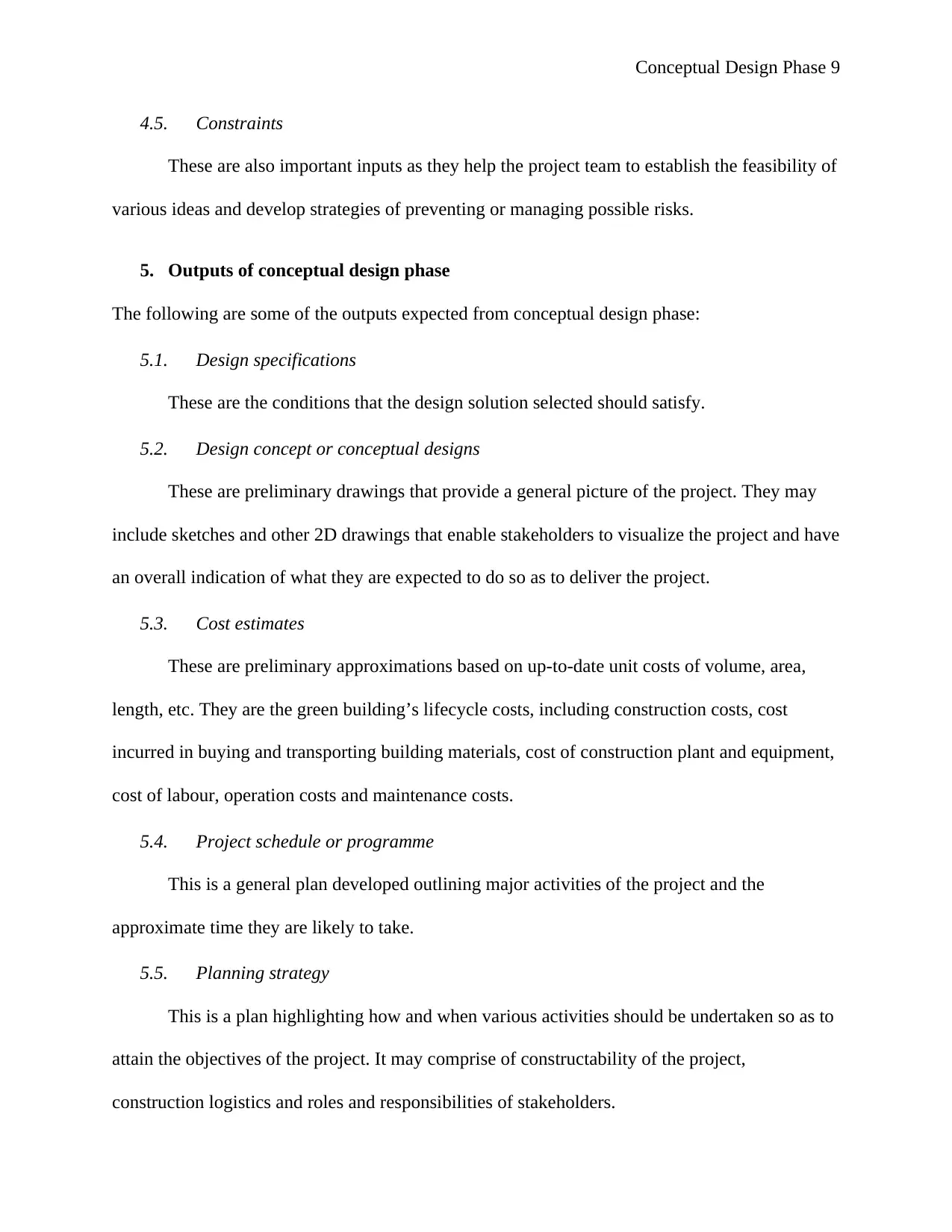
Conceptual Design Phase 9
4.5. Constraints
These are also important inputs as they help the project team to establish the feasibility of
various ideas and develop strategies of preventing or managing possible risks.
5. Outputs of conceptual design phase
The following are some of the outputs expected from conceptual design phase:
5.1. Design specifications
These are the conditions that the design solution selected should satisfy.
5.2. Design concept or conceptual designs
These are preliminary drawings that provide a general picture of the project. They may
include sketches and other 2D drawings that enable stakeholders to visualize the project and have
an overall indication of what they are expected to do so as to deliver the project.
5.3. Cost estimates
These are preliminary approximations based on up-to-date unit costs of volume, area,
length, etc. They are the green building’s lifecycle costs, including construction costs, cost
incurred in buying and transporting building materials, cost of construction plant and equipment,
cost of labour, operation costs and maintenance costs.
5.4. Project schedule or programme
This is a general plan developed outlining major activities of the project and the
approximate time they are likely to take.
5.5. Planning strategy
This is a plan highlighting how and when various activities should be undertaken so as to
attain the objectives of the project. It may comprise of constructability of the project,
construction logistics and roles and responsibilities of stakeholders.
4.5. Constraints
These are also important inputs as they help the project team to establish the feasibility of
various ideas and develop strategies of preventing or managing possible risks.
5. Outputs of conceptual design phase
The following are some of the outputs expected from conceptual design phase:
5.1. Design specifications
These are the conditions that the design solution selected should satisfy.
5.2. Design concept or conceptual designs
These are preliminary drawings that provide a general picture of the project. They may
include sketches and other 2D drawings that enable stakeholders to visualize the project and have
an overall indication of what they are expected to do so as to deliver the project.
5.3. Cost estimates
These are preliminary approximations based on up-to-date unit costs of volume, area,
length, etc. They are the green building’s lifecycle costs, including construction costs, cost
incurred in buying and transporting building materials, cost of construction plant and equipment,
cost of labour, operation costs and maintenance costs.
5.4. Project schedule or programme
This is a general plan developed outlining major activities of the project and the
approximate time they are likely to take.
5.5. Planning strategy
This is a plan highlighting how and when various activities should be undertaken so as to
attain the objectives of the project. It may comprise of constructability of the project,
construction logistics and roles and responsibilities of stakeholders.
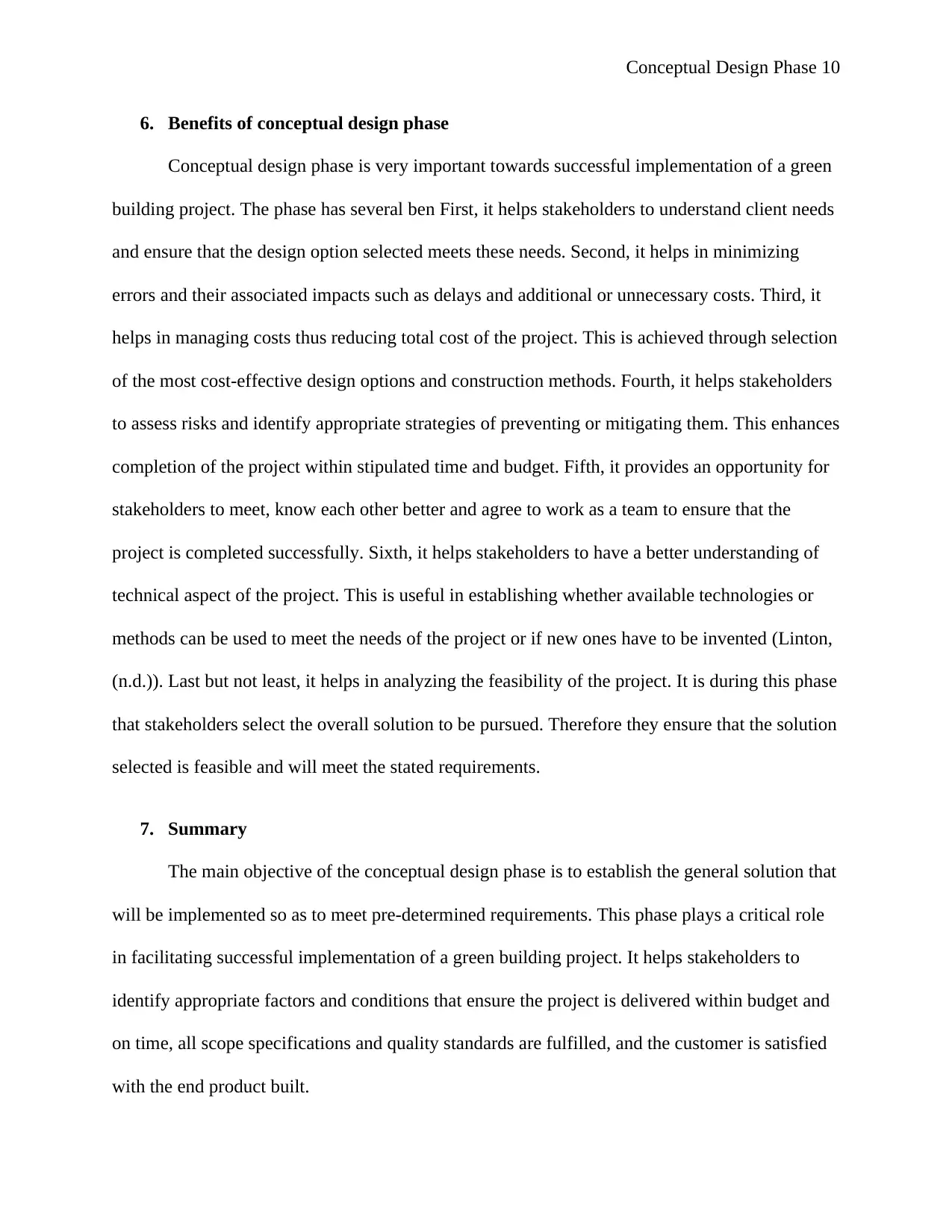
Conceptual Design Phase 10
6. Benefits of conceptual design phase
Conceptual design phase is very important towards successful implementation of a green
building project. The phase has several ben First, it helps stakeholders to understand client needs
and ensure that the design option selected meets these needs. Second, it helps in minimizing
errors and their associated impacts such as delays and additional or unnecessary costs. Third, it
helps in managing costs thus reducing total cost of the project. This is achieved through selection
of the most cost-effective design options and construction methods. Fourth, it helps stakeholders
to assess risks and identify appropriate strategies of preventing or mitigating them. This enhances
completion of the project within stipulated time and budget. Fifth, it provides an opportunity for
stakeholders to meet, know each other better and agree to work as a team to ensure that the
project is completed successfully. Sixth, it helps stakeholders to have a better understanding of
technical aspect of the project. This is useful in establishing whether available technologies or
methods can be used to meet the needs of the project or if new ones have to be invented (Linton,
(n.d.)). Last but not least, it helps in analyzing the feasibility of the project. It is during this phase
that stakeholders select the overall solution to be pursued. Therefore they ensure that the solution
selected is feasible and will meet the stated requirements.
7. Summary
The main objective of the conceptual design phase is to establish the general solution that
will be implemented so as to meet pre-determined requirements. This phase plays a critical role
in facilitating successful implementation of a green building project. It helps stakeholders to
identify appropriate factors and conditions that ensure the project is delivered within budget and
on time, all scope specifications and quality standards are fulfilled, and the customer is satisfied
with the end product built.
6. Benefits of conceptual design phase
Conceptual design phase is very important towards successful implementation of a green
building project. The phase has several ben First, it helps stakeholders to understand client needs
and ensure that the design option selected meets these needs. Second, it helps in minimizing
errors and their associated impacts such as delays and additional or unnecessary costs. Third, it
helps in managing costs thus reducing total cost of the project. This is achieved through selection
of the most cost-effective design options and construction methods. Fourth, it helps stakeholders
to assess risks and identify appropriate strategies of preventing or mitigating them. This enhances
completion of the project within stipulated time and budget. Fifth, it provides an opportunity for
stakeholders to meet, know each other better and agree to work as a team to ensure that the
project is completed successfully. Sixth, it helps stakeholders to have a better understanding of
technical aspect of the project. This is useful in establishing whether available technologies or
methods can be used to meet the needs of the project or if new ones have to be invented (Linton,
(n.d.)). Last but not least, it helps in analyzing the feasibility of the project. It is during this phase
that stakeholders select the overall solution to be pursued. Therefore they ensure that the solution
selected is feasible and will meet the stated requirements.
7. Summary
The main objective of the conceptual design phase is to establish the general solution that
will be implemented so as to meet pre-determined requirements. This phase plays a critical role
in facilitating successful implementation of a green building project. It helps stakeholders to
identify appropriate factors and conditions that ensure the project is delivered within budget and
on time, all scope specifications and quality standards are fulfilled, and the customer is satisfied
with the end product built.
Secure Best Marks with AI Grader
Need help grading? Try our AI Grader for instant feedback on your assignments.
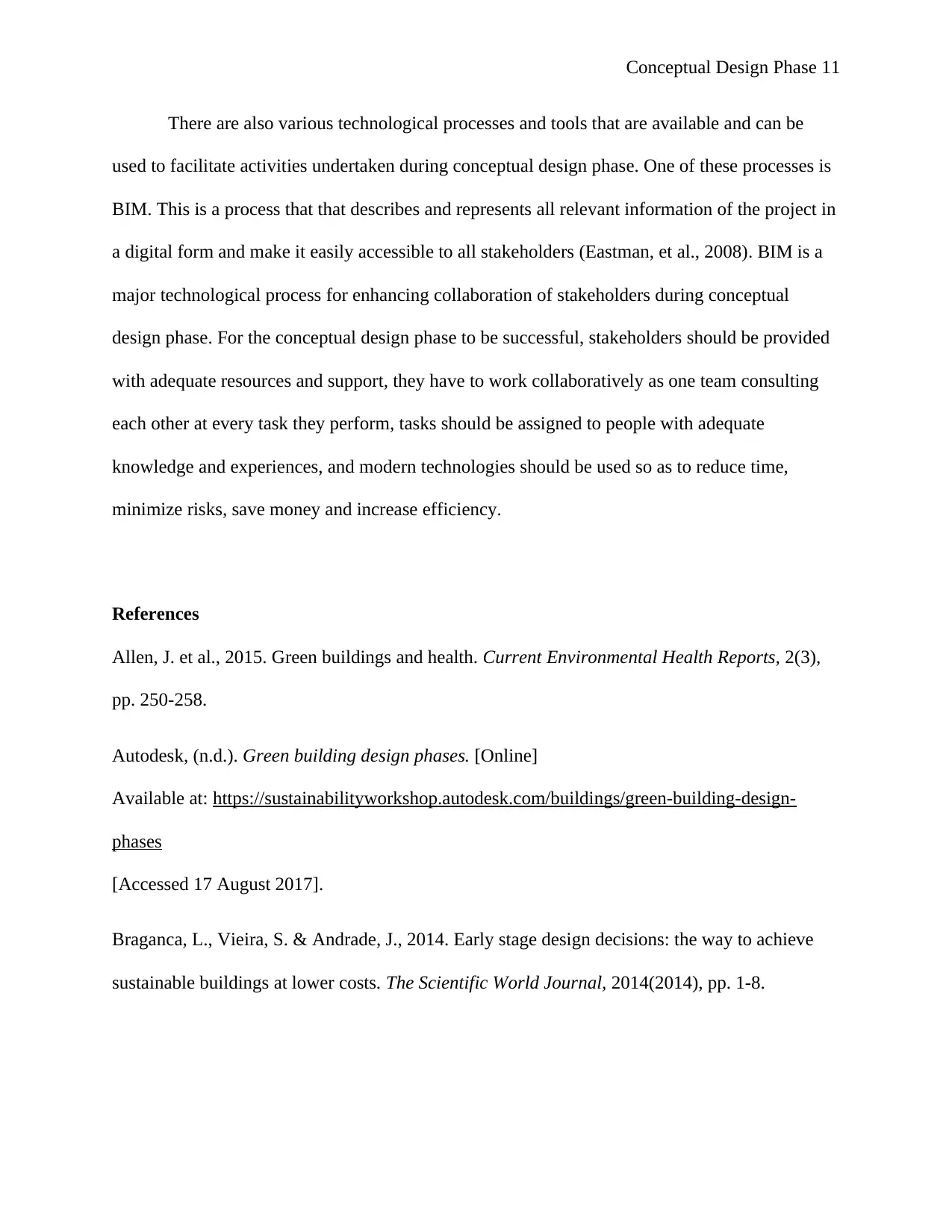
Conceptual Design Phase 11
There are also various technological processes and tools that are available and can be
used to facilitate activities undertaken during conceptual design phase. One of these processes is
BIM. This is a process that that describes and represents all relevant information of the project in
a digital form and make it easily accessible to all stakeholders (Eastman, et al., 2008). BIM is a
major technological process for enhancing collaboration of stakeholders during conceptual
design phase. For the conceptual design phase to be successful, stakeholders should be provided
with adequate resources and support, they have to work collaboratively as one team consulting
each other at every task they perform, tasks should be assigned to people with adequate
knowledge and experiences, and modern technologies should be used so as to reduce time,
minimize risks, save money and increase efficiency.
References
Allen, J. et al., 2015. Green buildings and health. Current Environmental Health Reports, 2(3),
pp. 250-258.
Autodesk, (n.d.). Green building design phases. [Online]
Available at: https://sustainabilityworkshop.autodesk.com/buildings/green-building-design-
phases
[Accessed 17 August 2017].
Braganca, L., Vieira, S. & Andrade, J., 2014. Early stage design decisions: the way to achieve
sustainable buildings at lower costs. The Scientific World Journal, 2014(2014), pp. 1-8.
There are also various technological processes and tools that are available and can be
used to facilitate activities undertaken during conceptual design phase. One of these processes is
BIM. This is a process that that describes and represents all relevant information of the project in
a digital form and make it easily accessible to all stakeholders (Eastman, et al., 2008). BIM is a
major technological process for enhancing collaboration of stakeholders during conceptual
design phase. For the conceptual design phase to be successful, stakeholders should be provided
with adequate resources and support, they have to work collaboratively as one team consulting
each other at every task they perform, tasks should be assigned to people with adequate
knowledge and experiences, and modern technologies should be used so as to reduce time,
minimize risks, save money and increase efficiency.
References
Allen, J. et al., 2015. Green buildings and health. Current Environmental Health Reports, 2(3),
pp. 250-258.
Autodesk, (n.d.). Green building design phases. [Online]
Available at: https://sustainabilityworkshop.autodesk.com/buildings/green-building-design-
phases
[Accessed 17 August 2017].
Braganca, L., Vieira, S. & Andrade, J., 2014. Early stage design decisions: the way to achieve
sustainable buildings at lower costs. The Scientific World Journal, 2014(2014), pp. 1-8.
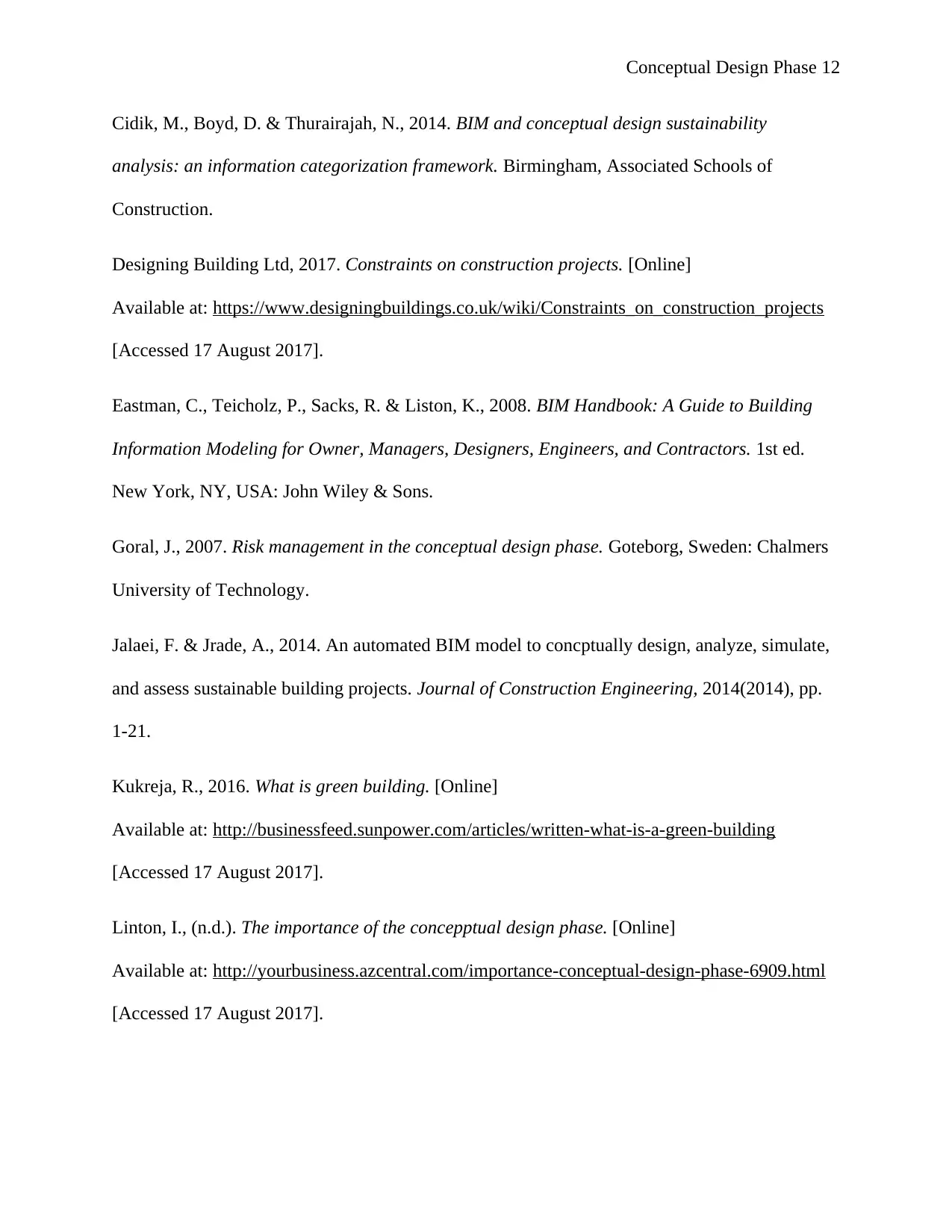
Conceptual Design Phase 12
Cidik, M., Boyd, D. & Thurairajah, N., 2014. BIM and conceptual design sustainability
analysis: an information categorization framework. Birmingham, Associated Schools of
Construction.
Designing Building Ltd, 2017. Constraints on construction projects. [Online]
Available at: https://www.designingbuildings.co.uk/wiki/Constraints_on_construction_projects
[Accessed 17 August 2017].
Eastman, C., Teicholz, P., Sacks, R. & Liston, K., 2008. BIM Handbook: A Guide to Building
Information Modeling for Owner, Managers, Designers, Engineers, and Contractors. 1st ed.
New York, NY, USA: John Wiley & Sons.
Goral, J., 2007. Risk management in the conceptual design phase. Goteborg, Sweden: Chalmers
University of Technology.
Jalaei, F. & Jrade, A., 2014. An automated BIM model to concptually design, analyze, simulate,
and assess sustainable building projects. Journal of Construction Engineering, 2014(2014), pp.
1-21.
Kukreja, R., 2016. What is green building. [Online]
Available at: http://businessfeed.sunpower.com/articles/written-what-is-a-green-building
[Accessed 17 August 2017].
Linton, I., (n.d.). The importance of the concepptual design phase. [Online]
Available at: http://yourbusiness.azcentral.com/importance-conceptual-design-phase-6909.html
[Accessed 17 August 2017].
Cidik, M., Boyd, D. & Thurairajah, N., 2014. BIM and conceptual design sustainability
analysis: an information categorization framework. Birmingham, Associated Schools of
Construction.
Designing Building Ltd, 2017. Constraints on construction projects. [Online]
Available at: https://www.designingbuildings.co.uk/wiki/Constraints_on_construction_projects
[Accessed 17 August 2017].
Eastman, C., Teicholz, P., Sacks, R. & Liston, K., 2008. BIM Handbook: A Guide to Building
Information Modeling for Owner, Managers, Designers, Engineers, and Contractors. 1st ed.
New York, NY, USA: John Wiley & Sons.
Goral, J., 2007. Risk management in the conceptual design phase. Goteborg, Sweden: Chalmers
University of Technology.
Jalaei, F. & Jrade, A., 2014. An automated BIM model to concptually design, analyze, simulate,
and assess sustainable building projects. Journal of Construction Engineering, 2014(2014), pp.
1-21.
Kukreja, R., 2016. What is green building. [Online]
Available at: http://businessfeed.sunpower.com/articles/written-what-is-a-green-building
[Accessed 17 August 2017].
Linton, I., (n.d.). The importance of the concepptual design phase. [Online]
Available at: http://yourbusiness.azcentral.com/importance-conceptual-design-phase-6909.html
[Accessed 17 August 2017].
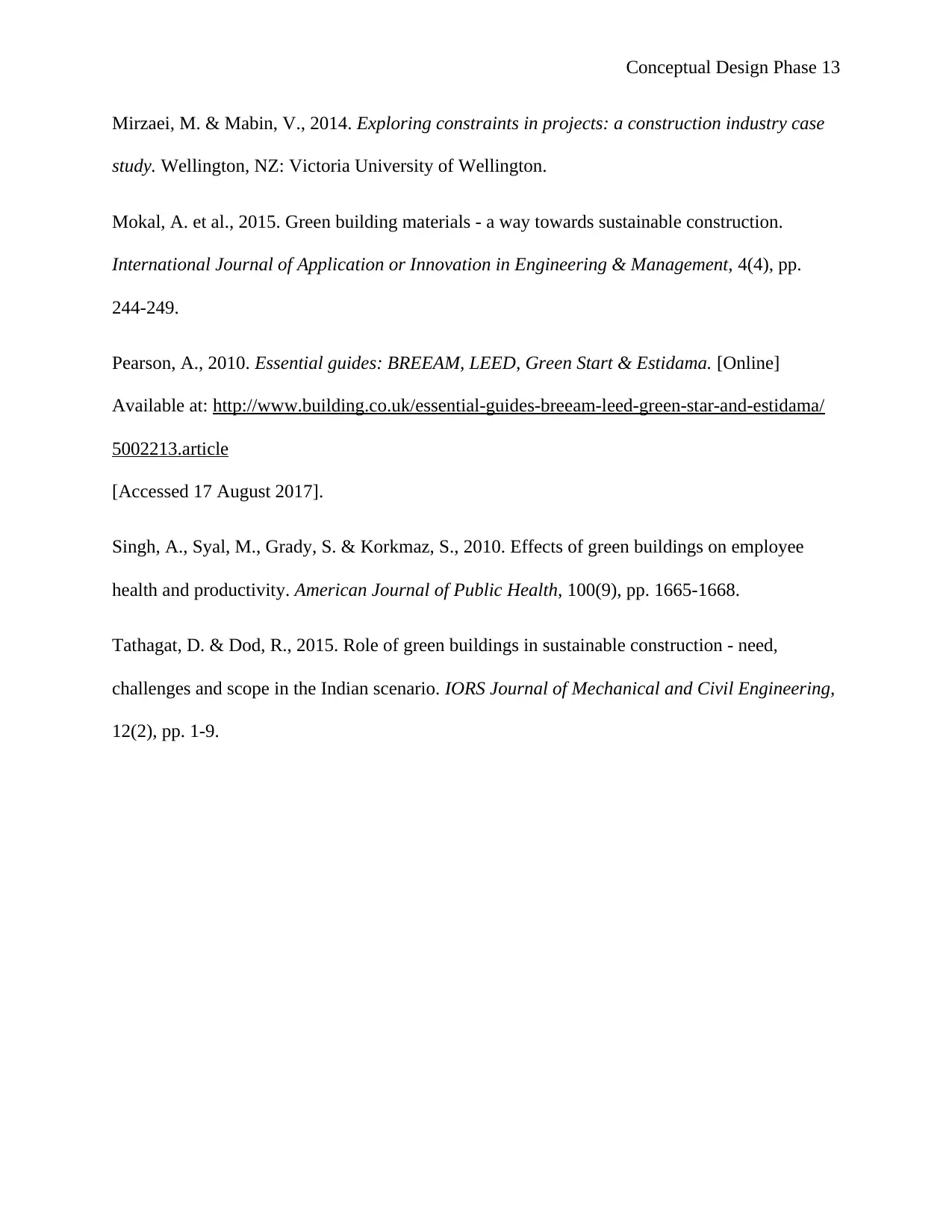
Conceptual Design Phase 13
Mirzaei, M. & Mabin, V., 2014. Exploring constraints in projects: a construction industry case
study. Wellington, NZ: Victoria University of Wellington.
Mokal, A. et al., 2015. Green building materials - a way towards sustainable construction.
International Journal of Application or Innovation in Engineering & Management, 4(4), pp.
244-249.
Pearson, A., 2010. Essential guides: BREEAM, LEED, Green Start & Estidama. [Online]
Available at: http://www.building.co.uk/essential-guides-breeam-leed-green-star-and-estidama/
5002213.article
[Accessed 17 August 2017].
Singh, A., Syal, M., Grady, S. & Korkmaz, S., 2010. Effects of green buildings on employee
health and productivity. American Journal of Public Health, 100(9), pp. 1665-1668.
Tathagat, D. & Dod, R., 2015. Role of green buildings in sustainable construction - need,
challenges and scope in the Indian scenario. IORS Journal of Mechanical and Civil Engineering,
12(2), pp. 1-9.
Mirzaei, M. & Mabin, V., 2014. Exploring constraints in projects: a construction industry case
study. Wellington, NZ: Victoria University of Wellington.
Mokal, A. et al., 2015. Green building materials - a way towards sustainable construction.
International Journal of Application or Innovation in Engineering & Management, 4(4), pp.
244-249.
Pearson, A., 2010. Essential guides: BREEAM, LEED, Green Start & Estidama. [Online]
Available at: http://www.building.co.uk/essential-guides-breeam-leed-green-star-and-estidama/
5002213.article
[Accessed 17 August 2017].
Singh, A., Syal, M., Grady, S. & Korkmaz, S., 2010. Effects of green buildings on employee
health and productivity. American Journal of Public Health, 100(9), pp. 1665-1668.
Tathagat, D. & Dod, R., 2015. Role of green buildings in sustainable construction - need,
challenges and scope in the Indian scenario. IORS Journal of Mechanical and Civil Engineering,
12(2), pp. 1-9.
1 out of 13
Related Documents
Your All-in-One AI-Powered Toolkit for Academic Success.
+13062052269
info@desklib.com
Available 24*7 on WhatsApp / Email
![[object Object]](/_next/static/media/star-bottom.7253800d.svg)
Unlock your academic potential
© 2024 | Zucol Services PVT LTD | All rights reserved.





